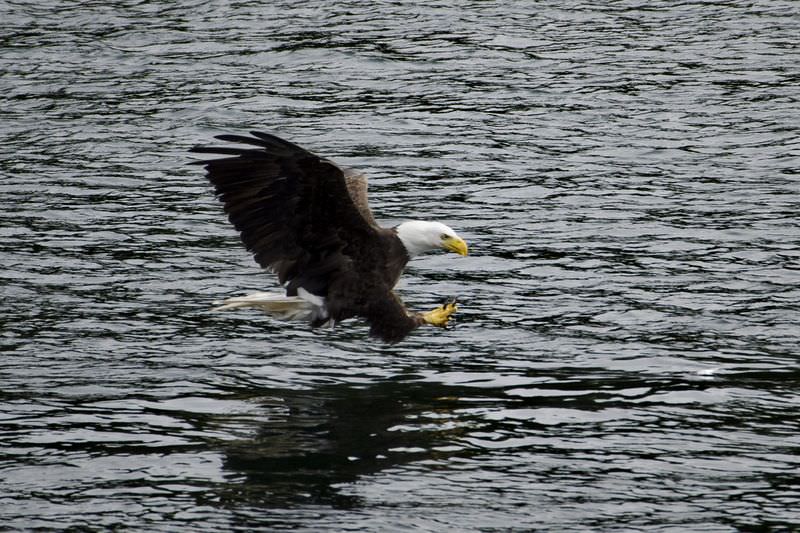8.10: Ponds and Lakes
- Page ID
- 5448
Why are lakes important?
Lakes are important habitats for lots of plants and animals. The slow motions of the water are easier for organisms to live in than the water from rapidly moving streams. Some animals live on land but get at least part of their food from lakes or ponds. This eagle is fishing for its meal. What would happen if lakes dried up?
Ponds and Lakes
After a heavy rain, you may find puddles of water standing in low spots. The same principle explains why water collects in ponds and lakes. Water travels downhill, so a depression in the ground fills with standing water. A pond is a small body of standing water. A lake is a large body of standing water. Most lakes have freshwater, but a few are salty. The Great Salt Lake in Utah is an example of a saltwater lake.
The water in a large lake may be so deep that sunlight cannot penetrate all the way to the bottom. Without sunlight, water plants and algae cannot live on the bottom of the lake. That’s because plants need sunlight for photosynthesis.
Water in Ponds and Lakes
Ponds and lakes may get their water from several sources. Some falls directly into them as precipitation. Some enters as runoff and some from streams and rivers. Water leaves ponds and lakes through evaporation and also as outflow.
How Lakes Form
The depression that allows water to collect to form a lake may come about in a variety of ways. The Great Lakes, for example, are glacial lakes. A glacial lake forms when a glacier scrapes a large hole in the ground. When the glacier melts, the water fills the hole and forms a lake. A kettle lake forms in the sediment left by a glacier when a block of ice melts. Kettle lakes are found where continental glaciers once covered the land (Figure below). Over time lakes get water from rain, streams, and groundwater coming to the surface.
A moose in a kettle lake at Denali National Park in Alaska.
Other lakes are crater lakes or rift lakes (Figure below). Crater lakes form when volcanic eruptions create craters that fill with water. Rift lakes form when movements of tectonic plates create low places that fill with water.
Craters and rifts become lakes when they fill with water. Where does the water come from?
The Great Lakes
Large lakes are similar to oceans. They have tides and currents. Large lakes can affect weather patterns. The Great Lakes (Figure below) contain 22% of the world’s fresh surface water. The largest of them, Lake Superior, has a tide that rises and falls several centimeters each day. The Great Lakes cause “lake effect” snow. In the winter, a large amount of snow may fall downwind of the relatively warm lakes. The Great Lakes are home to countless species of fish and wildlife.
The Great Lakes of North America get their name from their great size.
Reservoirs
Many lakes are not natural but are human-made. People dam a stream in a suitable spot. Water backs up behind the dam, creating a lake. These lakes are "reservoirs" (Figure below).
Hoover Dam, near Las Vegas, Nevada, creates a reservoir on the Colorado River. The reservoir is called Lake Mead.
Summary
- Ponds are small water bodies often fed by springs.
- A lake or pond may form wherever water can collect. A lake basin could be a volcanic crater, where a glacier has carved out a depression, or a fault zone.
- A reservoir is a man-made lake.
Review
- Describe how different types of lakes form.
- How is a large lake like an ocean? How is it different?
- What is the difference between ponds and lakes? How are they similar?






